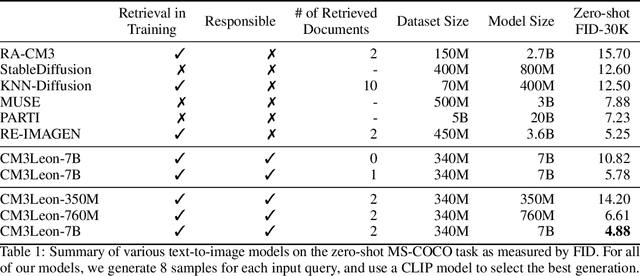Richard James
Scaling Autoregressive Multi-Modal Models: Pretraining and Instruction Tuning
Sep 05, 2023



Abstract:We present CM3Leon (pronounced "Chameleon"), a retrieval-augmented, token-based, decoder-only multi-modal language model capable of generating and infilling both text and images. CM3Leon uses the CM3 multi-modal architecture but additionally shows the extreme benefits of scaling up and tuning on more diverse instruction-style data. It is the first multi-modal model trained with a recipe adapted from text-only language models, including a large-scale retrieval-augmented pre-training stage and a second multi-task supervised fine-tuning (SFT) stage. It is also a general-purpose model that can do both text-to-image and image-to-text generation, allowing us to introduce self-contained contrastive decoding methods that produce high-quality outputs. Extensive experiments demonstrate that this recipe is highly effective for multi-modal models. CM3Leon achieves state-of-the-art performance in text-to-image generation with 5x less training compute than comparable methods (zero-shot MS-COCO FID of 4.88). After SFT, CM3Leon can also demonstrate unprecedented levels of controllability in tasks ranging from language-guided image editing to image-controlled generation and segmentation.
Reimagining Retrieval Augmented Language Models for Answering Queries
Jun 01, 2023Abstract:We present a reality check on large language models and inspect the promise of retrieval augmented language models in comparison. Such language models are semi-parametric, where models integrate model parameters and knowledge from external data sources to make their predictions, as opposed to the parametric nature of vanilla large language models. We give initial experimental findings that semi-parametric architectures can be enhanced with views, a query analyzer/planner, and provenance to make a significantly more powerful system for question answering in terms of accuracy and efficiency, and potentially for other NLP tasks
 Add to Chrome
Add to Chrome Add to Firefox
Add to Firefox Add to Edge
Add to Edge